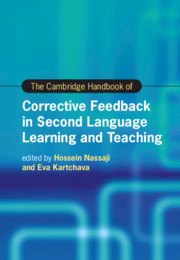Book contents
- The Cambridge Handbook of Corrective Feedback in Second Language Learning and Teaching
- Cambridge Handbooks in Language and Linguistics
- The Cambridge Handbook of Corrective Feedback in Second Language Learning and Teaching
- Copyright page
- Contents
- Figures
- Tables
- Contributors
- Acknowledgments
- Introduction Corrective Feedback in Second Language Teaching and Learning
- Part I Theoretical Perspectives on Corrective Feedback
- Part II Methodological Approaches in the Study of Corrective Feedback
- Part III Different Delivery Modes of Corrective Feedback
- Part IV Feedback Provider, Feedback Intensity, and Feedback Timing
- Part V Corrective Feedback and Language Skills
- 17 Corrective Feedback and the Development of Second Language Grammar
- 18 Corrective Feedback and the Development of Second Language Vocabulary
- 19 Effects of Corrective Feedback on Second Language Pronunciation Development
- 20 Corrective Feedback in Instructional Pragmatics
- 21 Alphabetic Print Literacy Level and Noticing Oral Corrective Feedback in SLA
- Part VI Contexts of Corrective Feedback and Their Effects
- Part VII Learners’ and Teachers’ Feedback Perspectives, Perceptions, and Preferences
- Part VIII Individual Differences, Tasks, and Other Language- and Learner-Related Factors
- Index
- References
19 - Effects of Corrective Feedback on Second Language Pronunciation Development
from Part V - Corrective Feedback and Language Skills
Published online by Cambridge University Press: 26 February 2021
- The Cambridge Handbook of Corrective Feedback in Second Language Learning and Teaching
- Cambridge Handbooks in Language and Linguistics
- The Cambridge Handbook of Corrective Feedback in Second Language Learning and Teaching
- Copyright page
- Contents
- Figures
- Tables
- Contributors
- Acknowledgments
- Introduction Corrective Feedback in Second Language Teaching and Learning
- Part I Theoretical Perspectives on Corrective Feedback
- Part II Methodological Approaches in the Study of Corrective Feedback
- Part III Different Delivery Modes of Corrective Feedback
- Part IV Feedback Provider, Feedback Intensity, and Feedback Timing
- Part V Corrective Feedback and Language Skills
- 17 Corrective Feedback and the Development of Second Language Grammar
- 18 Corrective Feedback and the Development of Second Language Vocabulary
- 19 Effects of Corrective Feedback on Second Language Pronunciation Development
- 20 Corrective Feedback in Instructional Pragmatics
- 21 Alphabetic Print Literacy Level and Noticing Oral Corrective Feedback in SLA
- Part VI Contexts of Corrective Feedback and Their Effects
- Part VII Learners’ and Teachers’ Feedback Perspectives, Perceptions, and Preferences
- Part VIII Individual Differences, Tasks, and Other Language- and Learner-Related Factors
- Index
- References
Summary
Given that the pedagogical potential of corrective feedback (CF) for second language (L2) pronunciation development has received rapidly increasing interest in recent years (e.g., Saito & Lyster, 2012 in Language Learning), it is timely and prudent to provide a piece of scholarly work which focuses on synthesizing and presenting the current state of affairs. According to existing descriptive studies, both teachers and learners equally consider the provision of CF to be a crucial component of L2 pronunciation development, especially when the errors in question hinder successful communication. More recently, a growing number of scholars have investigated the acquisitional value of pronunciation-focused CF by conducting quasi-experimental studies with a pre-test/post-test design in both classroom and laboratory settings. Whereas the results have generally shown that pronunciation-focused CF facilitates the development of both segmental and suprasegmental accuracy, the effectiveness of such CF techniques appears to be subject to a great deal of individual variability. Specifically, the potentials of pronunciation-focused CF can be maximized (a) when L2 learners have enough phonetic knowledge, conversational experience, and perceptual awareness of target sounds; (b) when CF provides model pronunciation forms (e.g., recasts rather than prompts); and (c) when the target of instruction concerns communicatively important and salient features.
Information
- Type
- Chapter
- Information
- The Cambridge Handbook of Corrective Feedback in Second Language Learning and Teaching , pp. 407 - 428Publisher: Cambridge University PressPrint publication year: 2021
References
Accessibility standard: Unknown
Why this information is here
This section outlines the accessibility features of this content - including support for screen readers, full keyboard navigation and high-contrast display options. This may not be relevant for you.Accessibility Information
- 20
- Cited by
